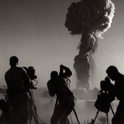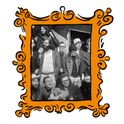(Picador, £16.99)
The death of Chilean novelist Roberto Bolaño in 2003 was not premature in the way rock-star deaths are premature, but for those familiar with his life and work, it was tragic. Born in Santiago in 1953, Bolaño moved to Mexico in 1968 with his parents, and was soon moving in Trotskyite poet-revolutionary circles. Returning to Santiago in the summer of 1973, Bolaño witnessed the military coup led by Augusto Pinochet on 11th September, and ended up in prison. He managed to escape by sheer luck—one of the guards recognised him as a childhood friend—and fled from his homeland, first to Mexico, later to Spain.
From the 1970s to the early 1990s, Bolaño wrote poetry and was extremely poor. In 1993 he published his first novel, La Pista del Hielo (The Ice Rink), and in 1998 his fourth, Los Detectives Salvajes (The Savage Detectives), which won him the prestigious Herralde and Rómulo Gallegos prizes and has now finally been translated into English. His death, by liver failure in a hospital in Blanes near Barcelona, came at the height of his career, as he was finishing off his 1,100-page magnum opus 2666.
Since his death, Bolaño has undergone a process of sanctification to rival that of WG Sebald. James Wood, John Banville and Susan Sontag have all called him the most influential writer of his generation. Nicole Krauss has compared his novels to "the slow-burning fuse of a bomb." It's impressive stuff, but just how significant is Bolaño?
The Savage Detectives is not just a detective novel, but also a literary novel. Not literary in the sense that contemporary English novels are literary—which is to say ponderous and elegiac—but in the sense that it is about people who care about literature. Most of Bolaño's characters are poets—lawyers moonlighting as poets, bums moonlighting as poets, mothers moonlighting as poets—and they spend their time either writing or reading books: at day and at night, at home and in public, even when masturbating.
The first section of the book, entitled "Mexicans lost in Mexico," is made up of the diary of 17-year-old law student Juan García Madero, who has "been cordially invited to join the visceral realists." He accepts, even though at first he is not entirely sure what visceral realism is. Literary movements in Latin America, he learns, are like political parties: the visceral realists are the sworn enemies of groups such as the "stridentists," "the neo-PRI-ists" and the "champions of otherness." They publish angry literary magazines that no one buys, interrupt stridentist poetry meetings and enter into a pact to assassinate "our great enemy," the Nobel prize-winning Mexican poet Octavio Paz. Bookish debates tend to end in punch-ups or duels at dawn. Literature, for Bolaño, is a matter of life and death.
Yet it is also ridiculous. The novel follows Madero as he gets to know various members of the movement and its two elusive leaders—Arturo Belano (a thinly veiled self-portrait of Bolaño) and his friend Ulises Lima. In reference to Easy Rider, they are described as "two Dennis Hoppers walking the streets of Mexico City." Together with Madero, they befriend a prostitute and rescue her from her pimp, speeding out of Mexico City in a dusty white Impala. The premise of the novel's middle section, which consists entirely of interviews with people they meet along the way, is not unlike that of Alfonso Cuarón's film Y Tu Mamá También, but their journey is infinitely more sprawling and aimless. Belano and Lima are searching for the supposed founding figure of the visceral realists, the poetess Cesárea Tinajero, who, we eventually realise, is no less obscure than visceral realism itself. She has only written one poem, called "Síon," which is made up entirely of squiggly lines.
The Savage Detectives, then, is a literary novel which doesn't take literature too seriously. For Bolaño, it's not literature but the dreams, ideals and ambitions symbolised by literary activity that matter.
Gabriel García Márquez, Carlos Fuentes and Mario Vargas Llosa, the titans of the first generation of Latin American literature, sought the soul of their nations in the soil: magical realism investigates local histories and family trees. Bolaño went beyond that formula and took the Latino spirit away from the Americas: the solitude explored in The Savage Detectives is the solitude of émigrés. In the novel's 400-page middle section, we brush past more than a hundred different characters, hailing from Mexico, Spain, France, Austria, Israel and Africa. Arturo Belano and Ulises Lima, the supposed subjects of this investigation, eventually disappear into the distance as the story of each interviewee moves into the foreground.
Bolaño's penchant for wisecracking motormouths means that his fiction has instant impact, but only at length does it reveal the brilliance to justify the adulation. His short stories, translated by Chris Andrews and collected in Last Evenings on Earth (published by Harvill Secker earlier this year), are enjoyable but not as exhilarating as this 608-page novel. The Savage Detectives shows us a writer who has found his ideal medium. It is a triptych: the sections on the outside and the detective story that frames the narrative are shorter, and less important, than the chaotically epic panorama of human life that fills the middle of the book.











